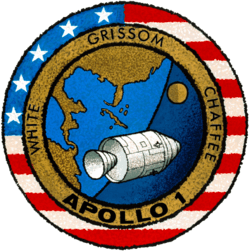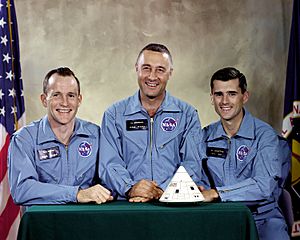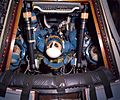Apollo 1 facts for kids

Grissom, White, and Chaffee in front of the launch pad containing their AS-204 space vehicle
|
|
| Names | AS-204 |
|---|---|
| Mission type | Crewed spacecraft verification test |
| Operator | NASA |
| Mission duration | Up to 14 days (planned) |
| Spacecraft properties | |
| Spacecraft | CSM-012 |
| Spacecraft type | Apollo Command/Service Module, Block I |
| Manufacturer | North American Aviation |
| Launch mass | 20,000 kilograms (45,000 lb) |
| Crew | |
| Crew size | 3 |
| Members | |
| Start of mission | |
| Launch date | February 21, 1967 (planned) |
| Rocket | Saturn IB AS-204 |
| Launch site | Cape Kennedy LC-34 |
| End of mission | |
| Destroyed | January 27, 1967 23:31:19 UTC |
| Orbital parameters | |
| Reference system | Geocentric |
| Regime | Low Earth orbit |
| Perigee | 220 kilometers (120 nmi) (planned) |
| Apogee | 300 kilometers (160 nmi) (planned) |
| Inclination | 31 degrees (planned) |
| Period | 89.7 minutes (planned) |
  Left to right: White, Grissom, Chaffee |
|
Apollo 1, also known as AS-204, was planned to be the first time astronauts would fly in the United States Apollo program. The main goal of the Apollo program was to send people to the Moon. Apollo 1 was meant to test the Apollo Command/Service Module in low Earth orbit.
However, the mission never launched on its planned date of February 21, 1967. On January 27, during a practice test at Cape Kennedy Air Force Station, a fire broke out inside the spacecraft. All three astronauts—Commander Virgil I. "Gus" Grissom, Senior Pilot Ed White, and Pilot Roger B. Chaffee—died in the fire. The Command Module (CM) was destroyed. To honor the astronauts, NASA officially retired the name Apollo 1 on April 24, 1967.
Contents
The Apollo Program: Reaching for the Moon
In 1959, NASA (the National Aeronautics and Space Administration) began working on sending people into space. They wanted to build special rockets and spacecraft that could carry astronauts and bring them back safely to Earth. At this time, the United States and the Soviet Union were in a competition called the Space Race. Both countries wanted to be the first to achieve major milestones in space.
The Soviet Union was ahead at first. They launched the first satellite into orbit and later sent the first person, Yuri Gagarin, into space. The United States felt they needed to catch up.
The first American space program, Project Mercury, successfully sent an astronaut named John Glenn into orbit around Earth in 1962. Later, during Project Gemini, an American astronaut, Ed White, performed the first "spacewalk" for the U.S. This meant he left his spaceship while in space and moved around outside. Even with these amazing achievements, the U.S. still felt behind because the Soviet Union had done similar things first.
Both the United States and the Soviet Union then set their sights on the same big goal: sending humans to the Moon. NASA's program to do this was called the Apollo program. Apollo 1 was supposed to be the very first flight of an Apollo spaceship. It wasn't going to the Moon itself. Instead, it would orbit Earth, allowing the astronauts to test all the equipment and machines needed for future Moon missions.
Meet the Crew: Apollo 1's Astronauts
Three brave men were chosen to be the crew of the Apollo 1 mission:
- Virgil Grissom (often called Gus Grissom)
- Ed White
- Roger B. Chaffee
Gus Grissom had already flown in space. He was the second American to go into space during a mission called Mercury-Redstone 4. His tiny spaceship was named "Liberty Bell 7."
Ed White had also been to space before. On the Gemini 4 mission, he became the first American to perform a "spacewalk." This meant he left the safety of his spaceship while in orbit and moved around outside in his spacesuit.
Roger Chaffee had not yet flown in space, but he was a highly skilled pilot. He had worked closely with the space program on the ground, helping astronauts during their missions. He was the person who communicated with the Gemini 4 crew during their spacewalk. NASA trusted him to fly special research jets to learn more about how rockets worked.
The Test and the Fire
Before any spacecraft can fly into space, it must go through many tests. These tests make sure everything works correctly and safely. For Apollo 1, the astronauts would practice everything they would do during a real mission. The only thing they wouldn't do was actually launch the rocket. This way, any problems could be found and fixed before the real flight.
On January 27, 1967, the Apollo 1 spacecraft was being tested on its launch pad in Florida. All three astronauts—Grissom, White, and Chaffee—were inside. The hatch (door) was closed, and the spacecraft was pressurized. This means there was more air inside than normal, which put more pressure on everything. This was done to check if the spacecraft was strong enough for space.
However, instead of normal air, the spacecraft was filled with pure oxygen. Normal air has only about 21% oxygen; most of the rest is a gas called nitrogen. In the Apollo 1 spacecraft, the air was 100% oxygen.
During the test, some electrical wiring created a spark. This spark quickly started a fire. A fire needs three things to burn: heat, fuel (something that can burn), and oxygen. In the Apollo 1 spacecraft, the air was pure oxygen, which made the fire grow very quickly and burn extremely hot. In just a few seconds, the fire was out of control.
The astronauts and the ground crew tried their best to open the hatch and get the three men out. But the high pressure inside the spacecraft pushed the hatch shut, making it impossible to open quickly. Gus Grissom, Ed White, and Roger Chaffee tragically died in the fire.
What Caused the Fire?
Even today, experts are not completely sure what exactly caused the spark that started the fire. Engineers carefully checked every part of the Apollo 1 spacecraft. They found several places where a spark could have started the fire. However, they couldn't pinpoint which one was the exact cause.
What they did learn was that there were many flammable materials inside the spacecraft. These are things that burn very easily. When these materials were combined with the pure oxygen inside the spacecraft, it created a very dangerous situation. All it needed was a small spark to start a serious fire.
After the Fire: Learning and Improving Safety
The news of the accident shocked the world. Americans were very sad about the loss of their astronauts. Even the Soviet Union, America's competitor in the space race, sent their condolences to the U.S. government.
The Apollo program was stopped for almost two years after the fire. During this time, engineers made many important changes to the Apollo spacecraft. They focused on making it much safer. They removed flammable materials, improved the wiring, and redesigned the hatch so it could be opened quickly in an emergency.
Today, many schools, buildings, and memorials are named after Grissom, White, and Chaffee to honor them. But perhaps their biggest legacy is the lasting change they brought to the space program. Since the Apollo 1 fire, there has never been another fire in an American spacecraft during a test or mission. Engineers learned a very painful lesson from Apollo 1 and have worked tirelessly to make sure such a tragedy never happens again.
Related pages
Images for kids
-
Command module 012, labeled Apollo One, arrives at Kennedy Space Center on August 26, 1966.
-
The Space Mirror Memorial at the Kennedy Space Center bears the names of Grissom, White, and Chaffee at the bottom middle.
-
Apollo 1 medallion flown on Apollo 9 by Jim McDivitt
See also
 In Spanish: Apolo 1 para niños
In Spanish: Apolo 1 para niños













